What is influencer marketing? In a nutshell, influencer marketing means that a brand or company works with an online influencer to help promote its products or services. Why is this relevant? Social media influencers can play a huge role in expanding a brand’s outreach; however, successful influencer marketing is not as simple as hiring anyone who has an online following.
Too many brands get involved in this endeavor without understanding the missteps of their predecessors. Before going further down this road, learn these common mistakes and save yourself time, money, and grief. Let this article serve as a guide to the harmful influencer marketing mistakes you want to avoid at all costs.
Table of Contents:
- Mistake #1: Forgetting to Position Your Brand as Purpose-Driven
- Mistake #2: Not Clearly Defining a Marketing Campaign Goal
- Mistake #3: Lacking Support from Your Influencers
- Mistake #4: Working with the Wrong Influencers
- Mistake #5: Prioritizing Reach Over Content
- Mistake #6: Not Considering Micro-Influencers
- Mistake #7: Not Having a Detailed Contract
- Mistake #8: Not Offering the Right Compensation
- Mistake #9: Not Maintaining Influencer Relationships
- Mistake #10: Building Uncreative Campaigns and Restricting Content
- Mistake #11: Not Engaging with Followers and Lacking Authenticity
- Mistake #12: Faking the Number of Your Followers
- Mistake #13: Failing to Recognize Your Competitors
- Mistake #14: Focusing on the Sales Metric Alone
- Mistake #15: Using the Wrong Metrics and Neglecting Analysis
- Mistake #16: Failing to Experiment with Verticals (aka industries)
- Mistake #17: Using Poor Images, Hashtags and Descriptions
- Mistake #18: Giving Off a “Spammy” Vibe
- Mistake #19: Forgetting to Follow FTC Guidelines
Mistake #1: Forgetting to Position Your Brand as Purpose-Driven
This is an excellent video on purpose-driven marketing, which covers its benefits, challenges, as well as other important information on the topic.
The Fix:
Consumers today prefer to buy products or services from brands that stand for more than simply making money. Brands with a purpose or unique story lend themselves to creative marketing efforts that make them stand out from the crowd and help influencers sell their product.
If your brand supports charities or causes that align with your target audience, be sure to incorporate those into your influencer marketing efforts. Having a purpose today not only helps build your customer base and increase revenue, but it also helps to spread your brand’s purposeful message.
Did You Know?
To ensure success, marketers should work with influencers who are aligned with their brand’s values and personality.
Mistake #2: Not Clearly Defining a Marketing Campaign Goal
This video provides a helpful and practical approach to setting better marketing goals.
The Fix:
What do you see as the end result of your influencer marketing campaign? Do you want to increase conversion rates, raise awareness, gather usable consumer data, or improve customer loyalty? Determining a goal is imperative to selecting the right influencer, developing a relevant campaign, staying on target, and measuring your campaign’s performance. Regularly measuring results helps you improve your campaign over time so you’re more likely to achieve your goal.
Mistake #3: Lacking Support from Your Influencers
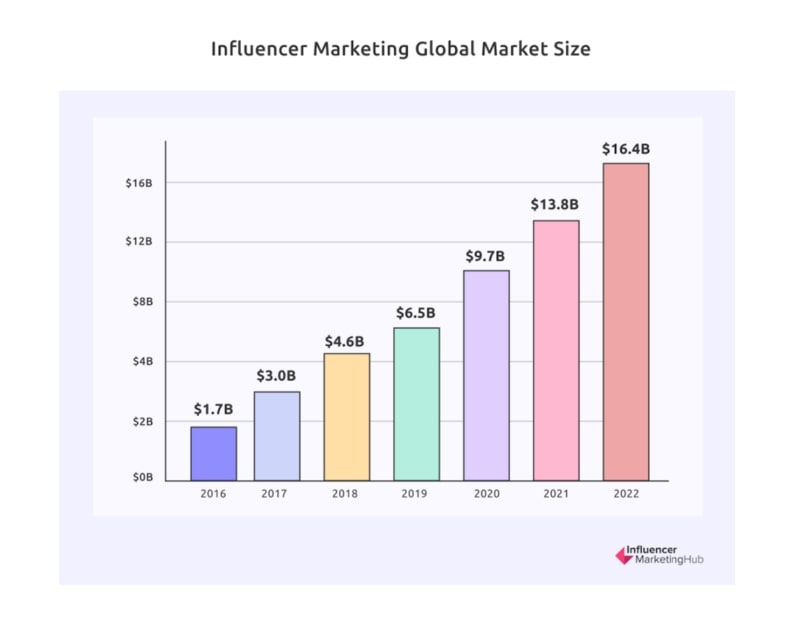
Source: Influencermarketinghub.com
The influencer marketing global market size jumped from $1.7 billion in 2016 to $13.8 billion in 2021. It is expected to grow to $16.4 billion in 2022.
The Fix:
Do you feel that your influencers are not sufficiently or properly supporting your brand? Ensuring that your brand’s story is correctly presented is on you, as the influencer may know nothing about your product or service beyond the information you offer. Provide your influencers with relevant material about your brand, product, or service; your campaign theme and hashtags; and whatever else you think will help them successfully promote your brand.
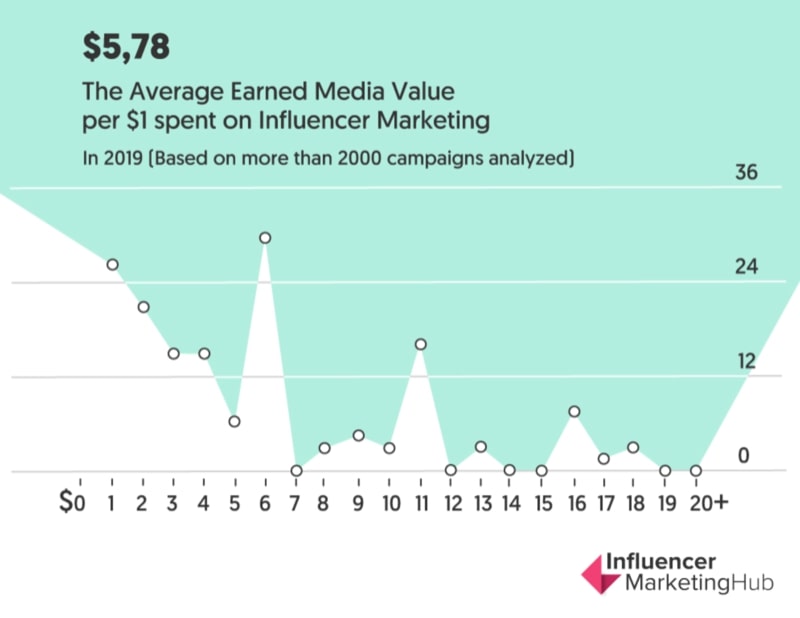
Source: Influencermarketinghub.com
For every $1 spent on influencer campaigns in 2019, most companies earned an average of $5.78. Some of these companies even earned more than $20 for every dollar they spent.
Mistake #4: Working with the Wrong Influencers
This video provides helpful information for how you can go about finding the right influencer for your brand.
The Fix:
A well-known influencer with a huge following is not necessarily the right person to promote your brand. Having a large audience is nice, but if the audience is not the right one for your brand, you’re wasting time and money. Not only can picking the wrong influencer be ineffective, but the wrong person can actually harm your reputation, particularly if he or she is known to disrespect brands online.
A few things you should consider before hiring influencers are their relevance to your industry, brand, and niche; their expertise in your field or with your product; and the level of engagement with their followers. Further, the right influencer is one who is easy to work with, responds in a timely manner, has the time to do the job well, posts good content and takes responsibility seriously. He or she should have already established some influence in your arena and have a significant number (thousands) of followers. Be sure to do your homework before hiring an influencer!
Did You Know?
Consumers prefer to follow influencers who look and act like them vs. celebrities.
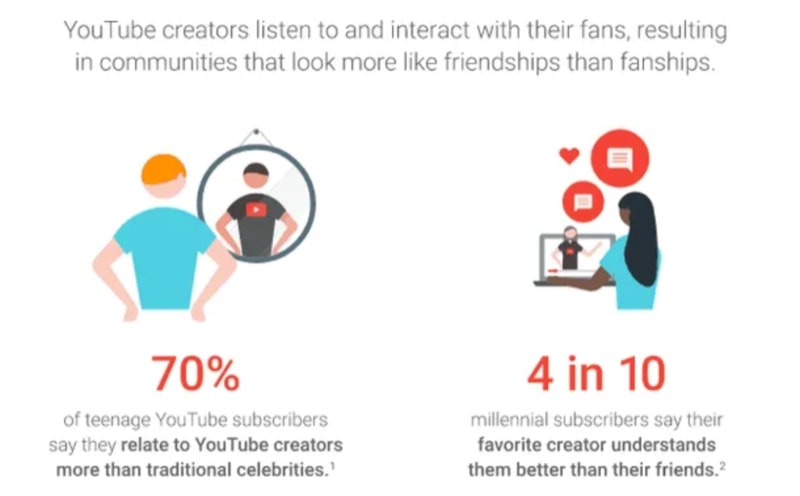
Source: Thinkwithgoogle.com
Mistake #5: Prioritizing Reach Over Content
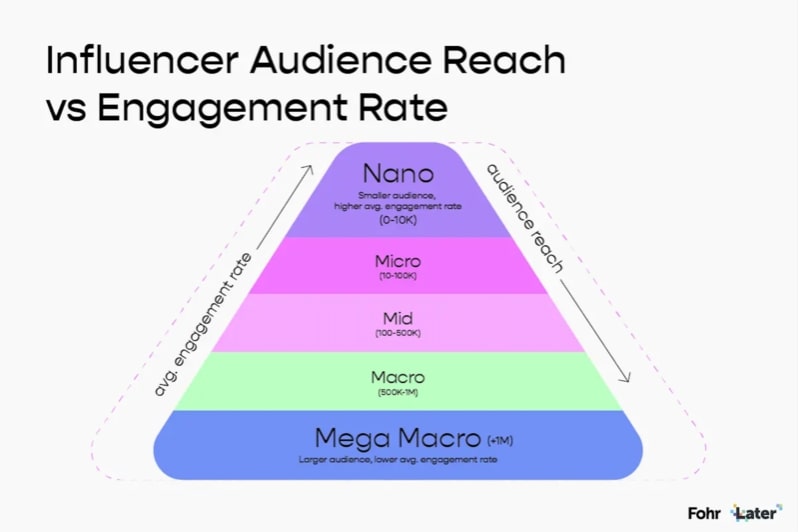
Source: Later.com
This image shows where each type of influencer (categorized by the number of followers they have) stands in relation to their average engagement rate and audience reach.
The Fix:
As mentioned previously, a large number of followers is not necessarily the best reason to select an influencer. Suitable content and high engagement with followers are more important than numbers. If the influencer’s content and/or language does not complement that of your target audience, then the followers are not going to convert, regardless of how many of them there are.
Many marketers have found that working with influencers with micro-level audiences (10,000 to 100,000 followers) is ideal. Such an audience size is large enough to make the investment worthwhile, yet small enough to permit interaction with the influencer’s audience. And the cost of a micro-level influencer is far more manageable than that of the typical A-list influencer.
Did You Know?
70.70% of nano-influencers (1K to 10k followers) receive less than $100 per post, on average, while 46.10% of mega-influencers (over one million followers) typically receive, on average, between $1,000 and $2,000 for every post.
Mistake #6: Not Considering Micro-Influencers
This video provides an influencer pricing formula to help you determine how much you should be paying for a specific micro-influencer, and it provides two examples of how this formula works, as well as additional information on what to look for when applying the formula.
The Fix:
Micro-influencers are those with 10,000 – 100,000 followers. While this may seem like a very small audience, compared to mega-influencers with over one million followers, these audience members may have niche interests that exactly align with your brand. And because they have fewer followers, these influencers tend to have high rates of engagement and a high percentage of followers who take their recommendations seriously.
How do you find these people? Reach out to your fan base and suggest exchanging a product for a review or post. Be sure that the micro-influencers you are considering post in a language that speaks to your target audience, have a lifestyle that complements your brand’s attributes, and are active with other influencers in addition to their own followers.
Mistake #7: Not Having a Detailed Contract
This video directs the viewer to a free influencer contract, and then explains each section of the contract in a practical and easy to understand way.
The Fix:
Your brand and your influencer both benefit from the protection offered by a detailed agreement or contract. Your document should provide all the details and key terms necessary for the job while addressing any potential loopholes. Be sure to include rules for the use, recycling, republishing and resharing of content, expected deliverables and a list of actions that may result in violations of the contract.
Mistake #8: Not Offering the Right Compensation
This video teaches you how to approach an influencer about pricing, and it provides two strategies you can use to utilize influencer marketing if your budget is currently too small to work with an influencer.
The Fix:
What are some issues regarding compensation? A payment amount that exceeds your budget or goals is a waste of money, as is making an agreed-upon payment ahead of time only to get poor results. Some marketers who offer to pay-per-click end up paying far more than anticipated when the results exceeded expectations. And paying for a post that you could get for free in exchange for a product or service is clearly an obvious mistake.
That being said, you want to ensure that you pay an amount that the influencer deems sufficient. How do you determine that amount? The best route may be trying out various payment models and then using the one that works best for your brand or campaign. Models include paying a flat rate per post, paying a set amount based on the level of engagement, paying a predetermined cost per click, providing free products or experiences in lieu of money, and paying a fee for each sale or subscription.
Did You Know?
34.5% of brands pay influencers in money, while the same amount (34.5%) pays influencers with product samples. 25% of brands give influencers product discounts.
Nearly 70% of influencers say that their main inspiration is to earn money.
Mistake #9: Not Maintaining Influencer Relationships
This video breaks down five things you can do to make sure your influencer relationships are strong and stay strong.
The Fix:
Marketers should treat successful influencers like employees. Creating and maintaining long-term relationships with influencers pays big dividends, especially when compared with the time and effort required to continually establish new, short-term relationships. Why start over when you have an influencer who knows your brand and understands how to help you achieve your goals? Don’t forget to thank your influencers through their posts at the end of each campaign and give them all the credit they deserve.
Did You Know?
A majority (56%) of brands use the same influencers across different campaigns.
Mistake #10: Building Uncreative Campaigns and Restricting Content
This is a very helpful interview in which two influencers explain why it’s so important for brands to give influencers artistic freedom, from both the influencer’s perspective, as well as from the brand’s perspective.
The Fix:
A fun and engaging campaign leads to better results than one that is plain and straightforward. Work with your influencers to create contests, polls, giveaways and more. Or consider giving your influencers creative control and let them create fresh, engaging content; after all, they may have more experience than you do!
If you want your influencers to sound natural, then let them have some say in the content creation. The audience trusts the influencer because they believe that he or she is authentic in their praise of the product, and if the content sounds scripted or boring, they will lose this trust. Experienced influencers understand how to engage their followers.
Did You Know?
60% of marketers believe that influencer-generated content performs better and drives more engagement than branded posts.
Influencers are asking for more creative control; 83% regard it as their first priority.
Mistake #11: Not Engaging with Followers and Lacking Authenticity
The following video covers eight game changing social media engagement hacks that will help you grow your brand.
The Fix:
Ignoring your followers negatively impacts your brand’s reputation. If your influencers lack the time to interact with every follower, you should step up and respond to each question to the best of your abilities. Also, be sure to thank your followers for their interest in your brand and for taking the time out to comment.
How do you communicate on social media? Using preplanned statements or cliches is not the answer. Personalize every communication with the name of the sender, request that the person tweeting sign off with his or her first name and show interest in your correspondents’ opinions or compliment them in some way. Spending time communicating authentically with followers yields valuable benefits now and in the future.
This video explains why it’s so important to be authentic on social media.
Mistake #12: Faking the Number of Your Followers
In this video, influencer Vanessa Lau explains five hacks that helped her grow her Instagram to 8,000 followers organically.
The Fix:
This is not only unethical, but faking followers is also easy to detect and can ruin your brand’s reputation. Do not buy fake followers or use bots to increase your numbers. The best solution to a low number of followers is to grow the number organically. Continue to communicate authentically with your followers by responding to their messages, posting original and engaging content and using relevant hashtags.
Mistake #13: Failing to Recognize Your Competitors
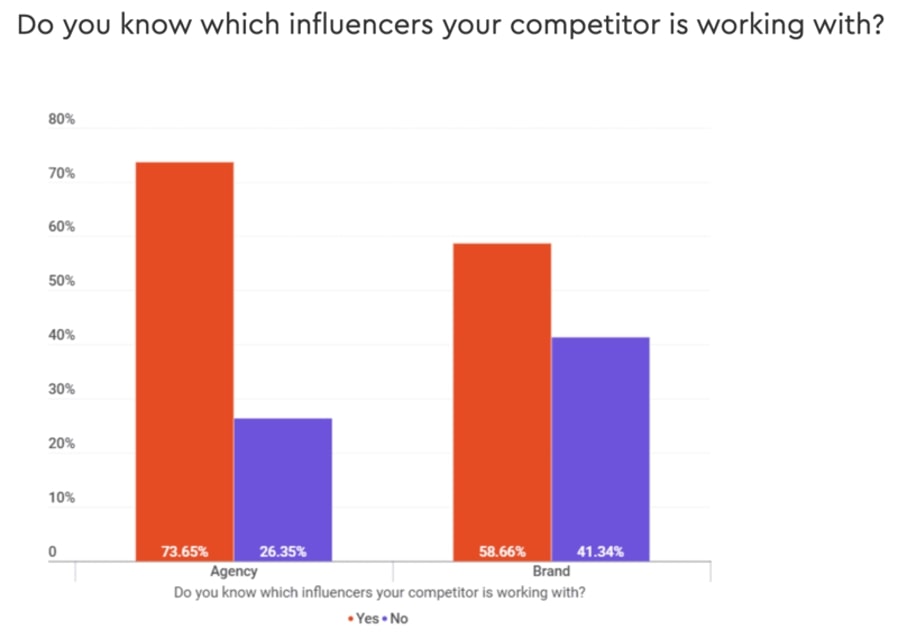
Source: Hypeauditor.com
In a survey of 330 respondents (149 agency representatives and 181 brand representatives) conducted by the influencer marketing platform, HypeAuditor, it was found that 41.34% of brands and 26.35% of agencies did not know which influencers their competition was working with.
The Fix:
Because influencers can work for any brand, you need to do your homework to determine which ones have promoted your competitors’ products. Do not even talk to an influencer who works for a competitor, let alone hire one! If you find an influencer on social media whose skills interest you, then carefully review their profiles and posts. If you discover that he or she has worked with a competitor, look for another influencer. It really is that simple!
Mistake #14: Focusing on the Sales Metric Alone
This video gives an excellent overview of the important performance metrics used in influencer marketing, including those related to the influencer selection process, brand visibility and awareness, sales, and the evaluation of a campaign.
The Fix:
Sales is not the only metric by which you should judge your influencer campaigns. While not directly measured by sales, metrics such as improved brand awareness, increased website traffic, earned media and new followers also indicate marketing successes.
If your products are relatively expensive, potential customers generally spend some time doing research before purchasing. Later purchases may not appear to have originated from the influencer’s posts when, in actuality, the post started the process, and the sale is ultimately attributable to influencer marketing.
Did You Know?
Unexpectedly, 30% of firms don’t measure their influencer marketing ROI.
Mistake #15: Using the Wrong Metrics and Neglecting Analysis
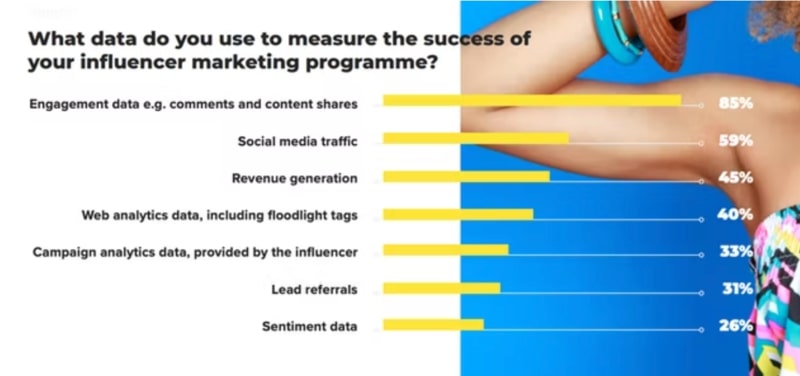
Source: Econsultancy.com
In a study published by Influencer Intelligence, an influencer engagement resource (partnered with Econsultancy.com, a research and analysis group), it was found that 85% of marketers used ‘engagement data’ to measure the success of their influencer marketing campaign.
The Fix:
Before beginning your campaign, you need to establish clear metrics for measuring performance. Without a set of well-defined key performance indicators (KPIs) and other metrics, how will you know how your influencer campaigns are progressing?
Common influencer marketing metrics are shares on social media, clicks, and comments, and social sentiment (tone, emotion, etc.). Evaluating metrics at the end of the campaign is vital to understanding what worked and what didn’t work, and it provides additional insights to help you determine how best to allocate future marketing budgets.
Here is another excellent video, which covers five helpful approaches for measuring ROI in an influencer marketing campaign.
Mistake #16: Failing to Experiment with Verticals (aka industries)
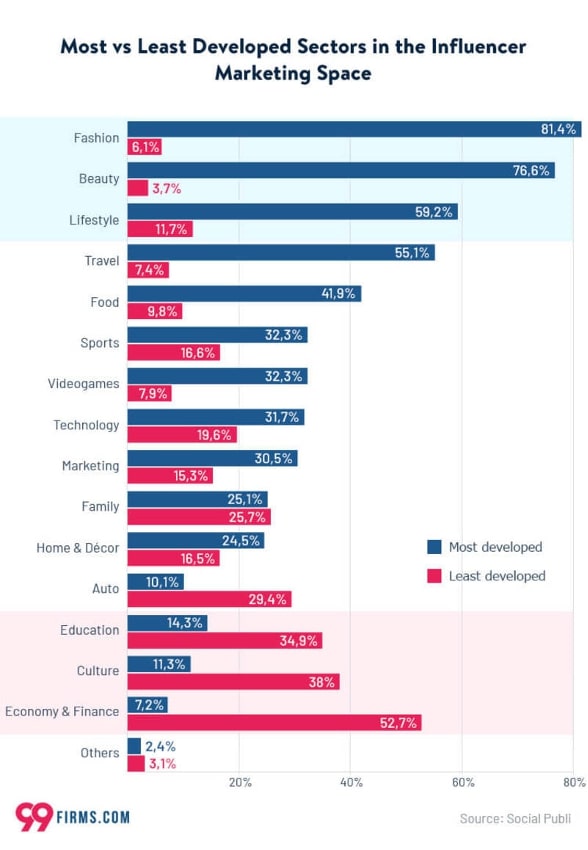
Source: 99firms.com
In a 2021 study conducted by Social Publi, a platform that connects brands with influencers, they collected data in relation to the most and least developed verticals in the influencer marketing space. ‘Fashion’ and ‘Beauty’ were found to be the most developed, while ‘Economy & Finance’ were found to be the least developed.
The Fix:
Are you stuck using influencers who represent only a few verticals? If your products or services are versatile enough to be useful in other areas, then try expanding your search. Brainstorm with others in your company to come up with a list of new, relevant verticals before beginning your next campaign. Be sure to measure the results of any experimental verticals so you can expand your campaigns over time into these additional areas.
Mistake #17: Using Poor Images, Hashtags and Descriptions
The Fix:
Images that don’t look good are not going to be effective; only high-quality images will attract the eyes of your target audience and encourage them to take further action. You need a phone with a good camera, or better yet, a top-of-the-line camera to do your product justice by portraying it in the most flattering way. Consider investing in easy-to-use photo-editing software and learn how to take advantage of its tools.
Using wrong or irrelevant hashtags or failing to fully explain the product’s features and benefits may result in lost sales and possible harm to your brand’s reputation. Try to write intriguing descriptions; you may want to consider taking a writing class or searching copywriting tips online. Watch out for hyperbole — overselling a product is as bad as underselling it.
Hashtags can also help you get found over social media, so learn to master them.
This is an excellent video that explains how Instagram Hashtags work, and how to use them.
This video explains a Hashtag ‘SEO strategy’ updated for year 2022.
Mistake #18: Giving Off a “Spammy” Vibe
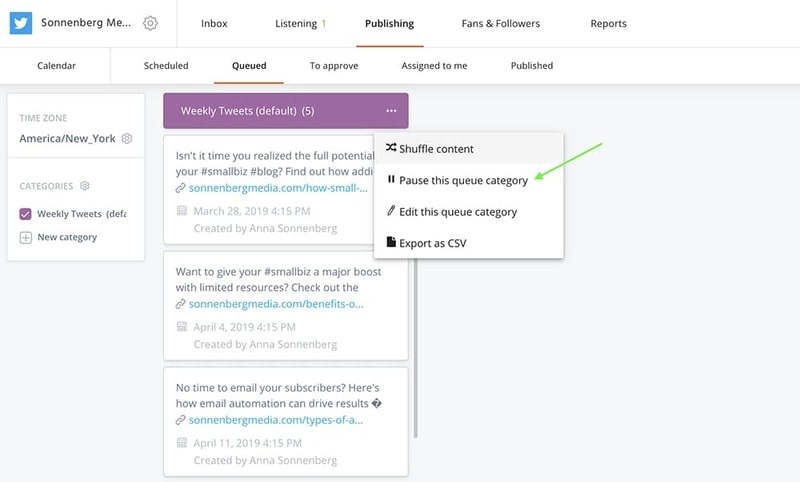
Source: Agorapulse.com
If your social media page continues to post your scheduled content during times of national/international crisis, or during the release of sensitive national or world news, it may be frowned upon by your followers. In these situations, pause your social media queue and save your great content for a better time.
The Fix:
Spamming your followers on social media is simply not acceptable. Not only is it wrong, but it can cause your customers to reject your brand. Also check your influencer’s posting schedule to ensure that he or she is not posting too often. Excessive posts may result in followers unfollowing your brand, while too few posts can cost sales. Finding the right balance requires experimentation.
Mistake #19: Forgetting to Follow FTC Guidelines
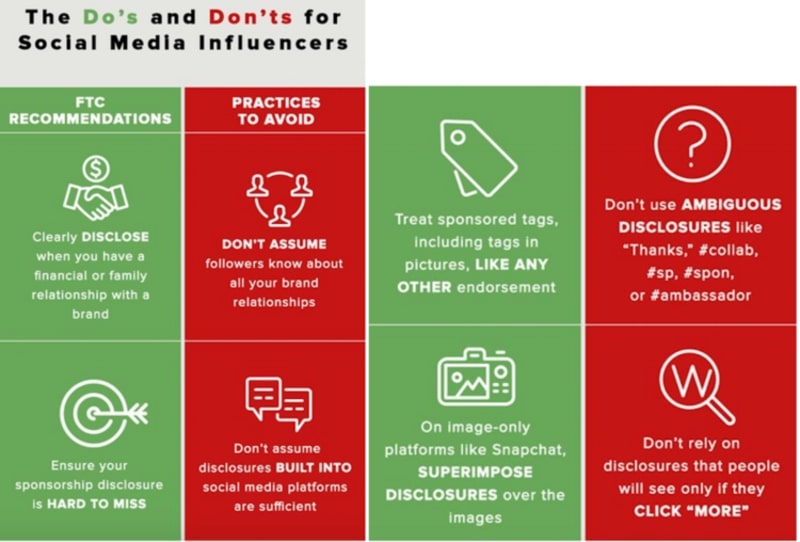
Source: Thefashionlaw.com
The Fix:
As a result of confusion that arose when influencer marketing took off, the FTC now requires that influencers disclose a sponsored collaboration or a paid partnership in a post’s description. Familiarize yourself with the FTC guidelines; they are available online at no cost. Influencers need to protect themselves before collaborating with a brand, and marketers are responsible for monitoring posts for false claims.
Did You Know?
20% of consumers are actually ready to stop following an influencer should he or she fail to be up-front about advertising or sponsorships.
Conclusion
Influencer marketing is growing for a good reason: It works! Whether influencer marketing is already an important part of your marketing plan and budget or you’re just getting started, avoiding the 19 mistakes discussed in this article will improve the outcome of your campaigns — and give you the best bang for your buck!






